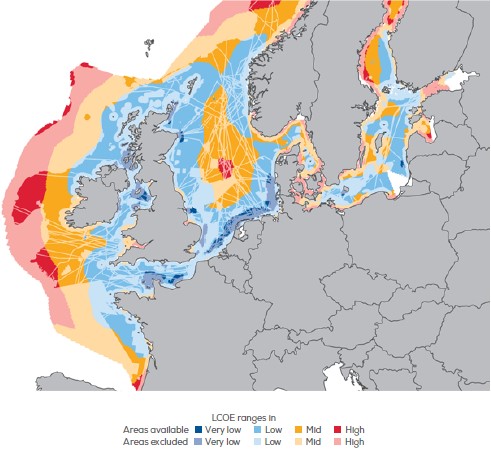Nyhet! Vi har lansert ny nettside. Del gjerne feedback enten på epost eller på Jodel.
 Annonsere?
Annonsere?
Nyhet! Vi har lansert ny nettside. Del gjerne feedback enten på epost eller på Jodel.
 Annonsere?
Annonsere?

In the framework of the European Green Deal, the new European Commission (EC) aims to make Europe the first climate-neutral continent by 2050. Norway can play an important part in achieving that goal through offshore wind.
Offshore wind is on the rise globally and represents a significant future opportunity due to stable and abundant resources available. Currently, Europe is the global technology leader and big players such as the USA, China, India and Japan are following. When it comes to offshore wind, Norway is starting from scratch with currently no large-scale projects deployed. However, having one of the longest coastlines in the world, the country could have a large potential for offshore wind energy generation.
Large potential to be exploited
Especially the North Sea provides great conditions with low offshore wind development cost, and the proximity to the Central European markets with high electricity prices such as Germany and the UK (see Figure 1). However, in Norway, many of these low-cost areas require floating technologies due to the water depth. The Norwegian energy company Equinor is the leading floating offshore wind developer in Europe. According to Equinor, 80% of the global offshore wind potential could only be exploited by floating technologies with the benefit of stronger and more consistent wind further out at sea.
The Danish energy company Ørsted is the largest offshore wind company globally, specialized in bottom-fixed technologies. However, they have not started any projects in Norway so far. Øyvind Vessia, Head of European Affairs at Ørsted, states: ‘Although LCOE of offshore wind is now lower than the costs of conventional electricity supply technologies (over the last year we have seen strike-prices between 40 and 50 €/MWh), there have been only a few projects without subsidies’. Although WindEurope expects low LCOE for some Norwegian sea areas, they still are projected to range between 50 and 65 €/MWh. Considering domestic electricity prices of around 39 €/MWh on average in 2019, it is hard to imagine a business case here. In addition, large areas of the Norwegian waters are too deep for bottom-fixed technologies and there, floating offshore wind is the only alternative.
You may also want to read: Kjernestyret frykter økt narkotikabruk i Kjelleren – nye rutiner og sikkerhetstiltak
Challenges to offshore wind development
There are some significant challenges to large-scale offshore wind development in Norway. For instance, about 60% of the North Seas area are currently excluded from offshore wind projects due to environmental protection measures and other uses. Although the public acceptance is much higher for offshore than for onshore wind (which recently has faced increasing opposition in Norway), there are still several stakeholders involved, representing potential sources for conflict. Especially the North Sea and Skagerrak - in the southern part of the Norwegian Continental Shelf (NCS) - are strongly influenced by human activity. These marine areas contain comprehensive shipping routes and are home to intensive fisheries as well as large-scale oil and gas industry. For addressing these issues, it requires a comprehensive integrated approach called maritime spatial planning (MSP), elaborated by the government and all the stakeholders involved. In that framework, the parties involved aim to optimise the use of sea areas under social, environmental and economic aspects. In addition, the target is to find synergies between various interests for a common usage of resources. For instance, offshore wind farm areas could overlap with fisheries or even promote biodiversity measures.

Although the abundant hydropower resources already ensure self-sufficient, clean and affordable energy provision for the country, it still makes sense to expand the renewable energy generation by offshore wind capacities. Norway has set the target to become carbon-neutral by 2050. Although the electricity generation is almost completely based on renewables, the renewable share of final energy consumption accounts for 60% only. Therefore, more direct and indirect electrification is needed for meeting the climate goals and by that, the electricity demand is going to increase significantly. According to Vessia, ‘the trick will be to think electricity grids together with offshore wind resources and possibly also onshore electrolysers, where hydrogen can be used in the sectors that cannot be directly electrified. Going forward, the big push for new capacity will not be to replace fossil fuels in power generation, but to serve the incredible increase in electricity demand coming from electrification’. Since hydropower resources are limited and already exploited to a large scale, offshore wind could provide energy for the additional demand.
You may also want to read: Vil ta over karrieredag-tronen på Vestlandet: – Jeg sprakk NHH-boblen med én gang
Diversifying Norwegian industries
Furthermore, with increased wind power production, electricity surplus could be stored in hydropower plants, serving as natural batteries and therefore, improve economics and security of supply. Cheap electricity could also be exported to countries in Continental Europe, partially compensating for the decreasing oil and natural gas revenues. Assuming 30 GW of offshore wind deployed in Norway in 2050 (as suggested by Wind Europe), half of the electricity produced could be exported via interconnectors. In addition, synergies with the existing offshore industry capabilities could be utilized and new job opportunities created. Last but not least, offshore wind provides an opportunity to diversify the Norwegian industries and partially base it on sustainable revenues, reducing the vulnerability to crisis.
As the IEA states, Norway acts ‘as a global advocate for climate change mitigation [and] is committed to environmental sustainability. As one of the world’s largest energy exporters, Norway advances the energy security of consuming countries’. Looking at this statement, large-scale offshore wind developments on the NCS seem to be the next logical step for creating benefits for both, Norway and the European Union.
Sources: ABB, Bloomberg, Equinor, European Commission, IEA, Nordic Energy Research, Nord Pool, NTNU, Ørsted, Reuters, The Maritime Executive, UNESCO, WindEurope.
Have you read these articles?